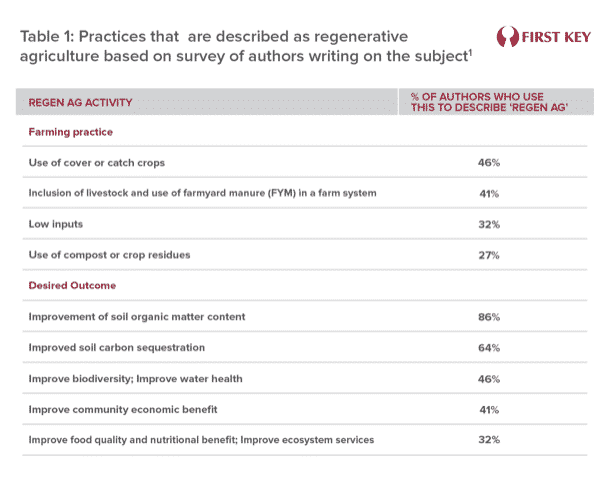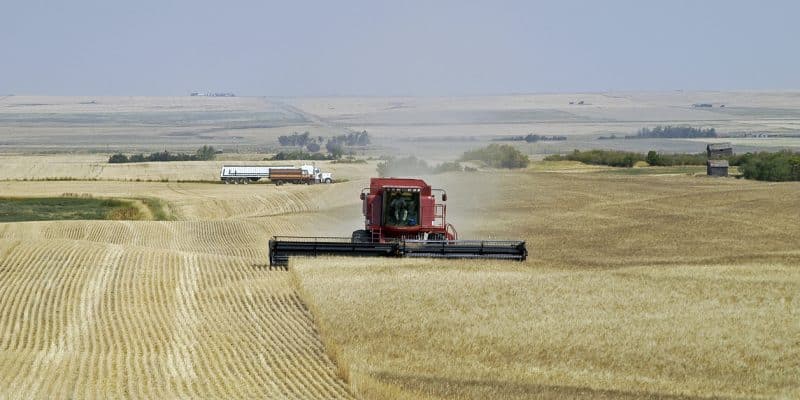Regenerative farming methods are gaining increasing interest and could provide a significant contribution to decarbonising the planet and creating a valuable new source of income for farmers. This could be of real interest to brewers seeking to offset carbon emissions from within their supply chain. These methods that genuinely reduce carbon are referred to as “insets” to differentiate from buying carbon credits from potentially unconnected supply chain activities just to balance a carbon budget.
Typically a beer will contain embedded carbon emissions from the contribution of malt of between 25-40% of the total carbon footprint. It is thus one of the major areas to be addressed in reducing the carbon footprint of beer.
The term regenerative agriculture (usually referred to as regen’ ag’) is used in various ways but always with the aim of improving soil health. Originally it was applied to farming systems that involved integrated mixed livestock and arable farming, but often is now applied to other farming options (Table 1).

Within the cereal sector the use of cover crops refers to planting a crop such as a legume mix (red/white clover, vetch) in the time between cereal harvest and replanting, to build biomass and capture carbon. These crops can be referred to as a “catch crop” if it is removed before the re-planting, whereas if left in the ground as permanent ground cover with the cereal crop sown (drilled) through it is a full cover crop. There is another variant whereby the cover crop is used between the lines of crops and is thus an inter-cropping system. In all these cases the role of the cover crop is to harvest carbon dioxide (carbon) from the atmosphere and create biomass above soil.
Why is an increase in soil organic content so important? It is not all about carbon sequestration and delivers additional benefits:
- 1% increase in soil organic matter improves drought resistance for 5-10 days
- Improvement in soil water retention also results in less run off of applied chemicals into local water courses
- Reduction in the amount of additional synthetic fertiliser required
- Increased resilience to flooding
- Improved soil structure
- Delivers soil carbon gains within weeks
- Far lower cost than tree planting
- No long-term land use change
- Increases Soil Organic Content By Weight (%)
The speed at which cover cropping sequesters carbon is impressive. Given the ideal weather conditions for planting a cover crop it can quickly establish and in a period of less than 90 days can accumulate carbon up to 5 times quicker than a mature forest. Given that a forest needs to have been growing for around 25 years before it starts to accumulate significant benefit it is clear why regen ag is seen as a unique and agile opportunity. Soil type affects the amount by which SOM can be improved (Table 2)

Carbon captured by cover crops is transferred into the soil via the root system which locks the carbon into the soil even if the above ground cover crop is subsequently removed. The locking in becomes more permanent when carbon is incorporated into the minute spaces between soil particles where even some microorganisms cannot get access to re-release it. The physical location for the organic matter is illustrated in Figure 1.

Regenerative agriculture is also referred to as carbon farming since it has the capacity to sequester more carbon than is associated with growing the cereal crop. ‘Carbon farming’ is specifically sequestration of atmospheric carbon into soil, roots, wood, and leaves. It is not only applied to cereal farming and has a wide scope:
- Afforestation and reforestation to promote biodiversity & sustainable forest management,
- Agroforestry combines trees/shrubs with crop or animal production systems on the same land,
- Use of catch crops, cover crops, conservation tillage; reduce erosion; enhance soil organic carbon,
- Targeted conversion of cropland to fallow or set-aside areas to permanent grassland,
- Restoration of peatlands and wetlands to increase the potential for carbon sequestration.
The recommended minimum soil organic matter content for soils (SOM) content is 3.4% (Greenland et al, 1975). For most soils an increase of 0.4% soil carbon could reduce atmospheric carbon by up to 3oC as proposed at COP21 when the “4 in 1000” initiative was launched[1]. With 20% of global arable land already severely degraded, it may seem impossible through such agronomic practices. However, the return on investment in food and agriculture is becoming higher than many sectors (Goedde et al, 2015).
Management of soil carbon and the associated reduction in fertilizer use has also been found to be the most effective way for cereal farmers to reduce on farm emissions. (Table 3)

In parallel with agronomic improvement there have been transformational reductions in the carbon emissions associated with fertiliser production.
There is much interest in adopting organic farming as a solution to GHG reduction. Organic practices which reduce pesticide use, minimize synthetic fertilizer application and encourage biodiversity are valuable. An often-ignored negative aspect is that organic cultivation relies on farmyard manure input, yet yields substantially below the output for regen ag solutions or even conventional cereal growing practices, suffering a significant yield penalty over conventionally grown cereals. Respiration of soil bacteria that are not locked into soil organic matter can increase GHG emissions after 3-5 years. Up to 90% of all surface biomass carbon and over 60% of all soil-incorporated carbon can return to the atmosphere within 36 months as a result of decomposition and microbial respiration. If the impact of land use change and the increased land required to achieve the same yield are accounted for, organic cultivation is not at this point a long-term solution to soil carbon sequestration.
Regenerative agriculture can thus create both a carbon offsetting opportunity and a way to increase margin for farmers without simply paying a premium. It is an innovative way to balance GHG emission reduction by acquiring genuine carbon negative credits that have taken additional carbon dioxide out of the atmosphere. There is the added bonus of de-risking the supply chain pressure that faces malting barley in a market where wheat can seem an easier option for greater financial return. If a brewer had access to carbon credits created during the growing of raw materials it would become more of an investment in the supply chain rather than a financial payment for carbon credits generated outside of malting and brewing activities.
By Dr. Nigel Davies, Senior Advisor, Technical Services and Sustainability
The 4 in 1000 initiative from the Paris Agreement https://www.4p1000.org/
Bryan,S., Fiocco, D., Issler, M., Mallya Perdur R.S. and Taksyak, M. 2020. Creating value in digital-farming solutions, McKinsey report.
Goedde, L., Horii, M., Sanghvi, S. 2015. Pursuing the global opportunity in food and agribusiness. McKinsey pursuing the global opportunity in food and agribusiness.pdf
Greenland, D.J., Rimmer, D. & Payne, D. 1975. Determination of the structural stability class of English & Welsh soils, using a water coherence test. Journal of Soil Science, 26, 294-303.
Syngenta. 2020. Climate Change Research Global Farmers https://www.syngenta.com/sites/syngenta/files/sustainability/the-good-growth-plan/GGP2/Syngenta-Climate-Change-Global-Farmers-2020-Report.pdf.
Vos, M., Wolf, A.B., Jennings, S.J., Kowalchuk, G.A. 2013, Micro-scale determinants of bacterial diversity in soil, FEMS Microbiology Reviews, Volume 37, Issue 6, November 2013, Pages 936–954, https://doi-org.nottingham.idm.oclc.org/10.1111/1574-6976.12023



